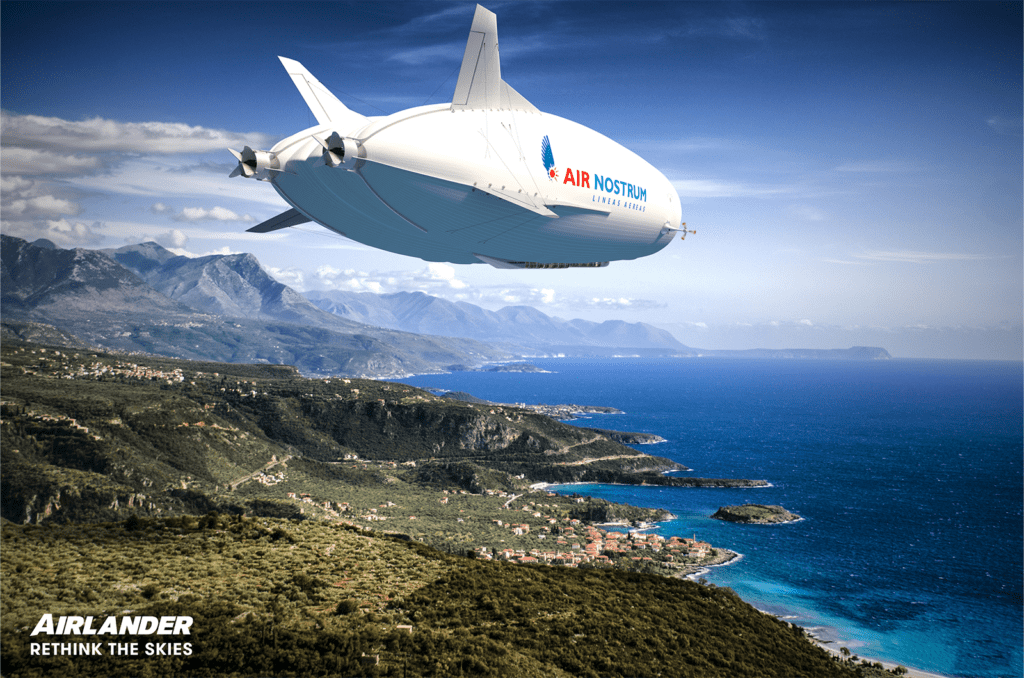
Hybrid Air Vehicles, the company designing the Airlander 10 hybrid-electric aircraft, entered into an agreement with Air Nostrum. As part of this agreement, Air Nostrum has reserved 10 aircraft from HAV for its fleet, with operations expected to begin in 2026. (Photo courtesy of Hybrid Air Vehicles)
Air Nostrum Group, one of Europe’s largest regional airlines, has reserved 10 hybrid-electric aircraft from the UK-based company Hybrid Air Vehicles (HAV). HAV’s aircraft design, the Airlander 10, is expected to launch in 2026, when Air Nostrum plans to begin operating the fleet of 10 aircraft in Spain.
“We’ve spent the last few years developing and testing a production design that’s going to work for many different customers,” Nick Allman, Chief Operating Officer at HAV, shared in an interview with Avionics International. The aircraft was originally designed with the military surveillance market in mind, but HAV has more recently shifted to focus on a much broader market.
The Airlander 10 will have a maximum speed of 80 miles per hour, and the maximum range is 4,000 nautical miles. The aircraft’s maximum payload is also expected to be about 22,000 pounds. The aircraft’s design includes a helium-filled hull to reduce the fuel required for keeping the vehicle airborne. HAV’s team intends to develop a version of the Airlander 10 that will be fully electric and ready to enter the market by the year 2030.
Interest in HAV’s fuel-efficient aircraft for short-haul mobility has grown in the past couple of years, in particular because of the increasing focus on sustainability for air travel. The Airlander 10 is designed to produce just about 10% of the emissions of a conventional aircraft. To meet the needs of the short-haul mobility market, Allman explained, they added a larger cabin to the aircraft with a 100-passenger capacity.
In addition to relatively short flights, HAV is also considering applications in the tourism market for its aircraft. This market “is more like a cruise liner in the sky,” he said, “for a two- to three-day flight at a relatively low altitude to go somewhere that’s very difficult to see otherwise.” The company continues to explore surveillance applications in line with the original design of the aircraft. The surveillance model of the vehicle would have 5+ days of endurance built in, and could serve both military and civilian communications applications.
“We have made changes to some of the basic aerodynamics of the aircraft” in the last couple of years, Allman mentioned. The changes have been primarily aimed at efficiency and ease of operation. The team at Hybrid Air Vehicles uses a flight simulator, which has been calibrated against flight test data from their prototype, to explore possible design changes and alternative methods of operation.

“We’ve spent the last few years developing and testing a production design that’s going to work for many different customers,” said Nick Allman, Chief Operating Officer at HAV. (Photo, courtesy of Hybrid Air Vehicles)
There have been plenty of obstacles in developing the Airlander 10. However, Allman said, they have gained a huge amount of experience as they progressed with the design. And that experience has enabled them to cross off a significant milestone: “We’re the only campaign to have flown a full-scale hybrid aircraft,” he noted.
The employment market in the U.K. is very strong right now, he said, which benefits HAV’s long-term strategy for growth. The company has about 60 employees at the moment, but expects to grow to nearly 2,000 within the next few years.
The team is collaborating with regulators in the U.S. and Europe in addition to those in the U.K. to ensure that the Airlander 10 is safe to operate once it enters the market in 2026. Production of the aircraft is set to begin later in 2022, in South Yorkshire, U.K. HAV is working particularly closely with local and central government as well as other partners to establish its facility there.
The European Union Aviation Safety Agency (EASA) awarded HAV a Design Organisation Approval (DOA) in 2018. That same year, the company also was awarded a Production Organisation Approval (POA) by the UK Civil Aviation Authority.
Hybrid Air Vehicles expects the Airlander 10 to fall under the same essential regulations as any large aircraft. “Whereas some of the small eVTOL type products are needing quite a significant regulatory change depending on their level of technology,” Allman explained, “we don’t need a regulatory change at any of those points in the chain to be able to successfully operate the aircraft.” One example of a difference in HAV’s aircraft is the lack of a metal undercarriage, an aspect of standard aircraft that is heavily regulated.
Allman shared that he doesn’t foresee any issues in the production phase, and their team is already working on the operational side of things, even though it’s four years away. “We feel completely confident that [regulations for the aircraft] won’t be a hurdle for us. We’re trying to stick as closely as possible to the way aircraft are regulated now,” he added.
Carlos Bertomeu, President of Air Nostrum, remarked in the announcement from HAV that they entered into this agreement because of the dramatic reduction in emissions offered by the Airlander 10 aircraft. “Sustainability is already a non-negotiable fact in the daily operations of commercial aviation,” Bertomeu said. “Agreements such as these are a very effective way to reach the de-carbonization targets contemplated in the Fit for 55 legislative initiative.”
In addition to the Airlander 10, Hybrid Air Vehicles has conceptualized a larger model called the Airlander 50 for heavy lift freight transportation. This vehicle’s design includes a payload of about 110,000 pounds or 55 tons, and a 200-passenger capacity. According to HAV, the fully electric version of the Airlander 50 could be available to customers by 2033.